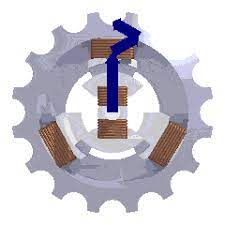A synchronous motor
A synchronous motor is a type of electric motor that works by synchronizing the rotating magnetic field in the stator (the fixed part of the motor) and the rotating disk or rotor (the moving part of the motor). In a synchronous motor, the rotation of the rotor coincides with changes in the frequency of the alternating current supplied to the stator. This ensures precisely synchronized rotation of the rotor with the magnetic field of the stator.

Advantages of synchronous motors include:
Speed stability: Synchronous motors have a stable speed, which is beneficial for applications where precise speed control is required.
High efficiency: Due to the synchronization between the rotor and the magnetic field, the efficiency of synchronous motors is usually higher than that of asynchronous motors.
Accurate speed: Synchronous motors are able to maintain accurate speed even when the load changes.
Use in generators: Synchronous motors can also be used as generators of electrical energy.
On the other hand, synchronous motors also have disadvantages:
Need for external frequency supply: To maintain synchronization between the rotor and the magnetic field, it is necessary to supply the frequency from outside, which can be a disadvantage in certain applications.
Higher cost: Synchronous motors are often more expensive than asynchronous motors, which can be important when choosing a motor for a particular application.
Synchronous motors are used in a variety of applications including industrial machinery, air conditioning systems, production lines and other applications where precise control of speed and power is required.
